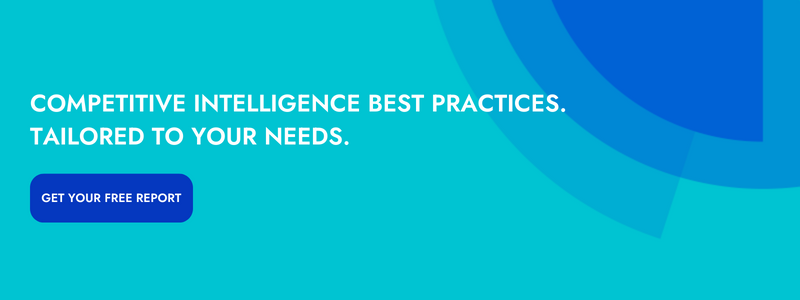Today is a great day because you’ve just been hired to spearhead a competitive intelligence (CI) program at your company. When you’re starting a new initiative and integrating a new practice into an existing business strategy, you want to make sure you’re as prepared as possible. Competitive intelligence has many moving parts and is a process that is never truly done, so laying a strong foundation is key.
You have to do more than just outline the process for capturing, analyzing, and acting upon your competitive intelligence insights. You need to build the program from the ground up — communicating with your key stakeholders, taking inventory of your current program (if there are any efforts in place), centralizing your competitive intelligence database, building new competitive intelligence deliverables, and communicating insights to your organization.
What should your priorities be when you’re building a competitive intelligence program? Let’s take a look at the steps you should take to set your program up for success.
Work Closely with your Key Stakeholders
If you’ve been hired to specifically build out a competitive intelligence function, or if you’ve been asked to integrate CI into your existing workflow, then you’ve likely already got buy-in from your key stakeholders for the initiative.
NEED COMPETITIVE INTELLIGENCE BEST PRACTICES? USE OUR FREE TOOL >>
But, their involvement goes beyond just buy-in. You want to ensure that your key stakeholders are all on the same page as to what is happening, when it’s happening, and why it’s happening. Your stakeholders care about the impact this program has on the organization, so tie as many of your early KPIs as possible to the organization.
Additionally, you want to keep an open line of communication with your key stakeholders. Ensure that you have an understanding of what competitive intelligence information is essential for their team, how they’d like to receive the information, and provide them with actionable insights to apply to their strategies - more on that later. When you’re gathering this information about your stakeholders, take note of how often they want to receive CI updates (daily, weekly, monthly, etc.) and through which channels they’d like to receive updates (Slack/chat, email, etc.)
Take Inventory of your Existing Competitive Intelligence Program
Just because your organization didn’t have a concrete competitive intelligence program in place doesn’t mean that no competitive intelligence was being done. Sometimes, organizations have bits and pieces of competitive intel in different locations, benefiting different teams on different projects.
For your own knowledge, you should identify which competitive intelligence strategies are already in place, discover where this competitive intelligence lives, and discover who has been putting all of this information together.
A great way to uncover this information is by interviewing your colleagues. Not only do you need to find the elements of competitive intelligence within your organization, but you also need to discover the impact, if any, that it has had on the organization.
Some key questions you can ask your colleagues include:
- What has been working for you from the existing competitive intelligence deliverables?
- What isn’t working well?
- What types of competitive intel do you wish you had at your fingertips?
By asking these key questions, you can gauge the success of the current CI efforts, as well as guide your next moves in building your new program. Once you’ve completed your research, you should go onto the next step, building a centralized database for your competitive intelligence insights.
Create a Centralized Database for Competitive Intelligence Information
You want to have a one-stop-shop for competitive intelligence information – ideally, a competitive intelligence platform. However, if you don’t have a CI solution on your radar, you can make your own centralized database for competitive intelligence.
While each team has its own workflow, you want to host your CI data in the most popular and most efficient platform for your team. Whether that’s within a simple Excel spreadsheet, a platform such as AirTable, the company Wiki, or your CRM – build your CI database in one, central location.
Transfer existing competitive intelligence data and deliverables to your new centralized location. That way, if there is a deliverable that has been working for your sales team, but just needs a little refresh, it will already be in your new database, and easily accessible for you to update with new competitive information.
The benefit of a centralized location is that you no longer have to answer the question, “where is that deliverable?” or “what is competitor x’s new pricing?” You’ll have all of your insights and deliverables in one place, packaged, and ready to go for your team to leverage.
Build Up-to-Date Competitive Intelligence Deliverables
Once you’ve got all of your competitive intelligence data in one location, you want to build up-to-date CI deliverables. Maybe you’ve got outdated battlecards or competitor profiles that could use a refresh. What about that old competitive one-pager? If these assets have been sitting idle until you joined the team, they could surely use a fresh coat of paint.
You should focus on your tier-one competitor (the competitor you come up against most often in the sales cycle) and build more assets for the rest of your competitive landscape as time goes on.
If you’ve got a collection of existing deliverables, figure out where the gaps are in your competitive intelligence database. Are you missing key tiles on your battlecards? Are you missing an entire battlecard on a specific competitor? Not only do you want to update your existing collateral, but you also want to build new collateral so that you have insights into your complete competitive landscape.
Communicate Competitive Intelligence Across Your Organization
Once you’ve updated existing collateral and built new collateral to fill in the gaps, you want to share this information with your team. When you first kicked off this new CI initiative, you connected with each of your stakeholders. Now, it’s time to circle back and show them what you’ve been working on.
Each stakeholder may prefer to have new intel communicated to them through a different medium, which is why it’s critical to connect with your stakeholders early on in the process to set expectations and build action plans.
Not only do you need to communicate the intel, but you should also provide specific guidelines and conduct team trainings so that your teams know how to leverage the competitive intelligence information as effectively as possible.
As the first competitive intelligence hire at your company, you’ve got a lot of power in scaling your competitive intelligence program from the ground up. It’s important to remember that competitive intelligence is always evolving, and the work is never done. You’ll want to keep an open line of communication with your key stakeholders across your organization. You’ll also want to keep refreshing your competitive intelligence deliverables as needed. Your organization will be thanking you for all of the hard work you’ve done to create a competitive intelligence program that will scale and provide your colleagues with a unique competitive advantage.

Seeing is believing! Check out Crayon for yourself.
Take a Product TourRelated Blog Posts
Popular Posts
-
 The 8 Free Market Research Tools and Resources You Need to Know
The 8 Free Market Research Tools and Resources You Need to Know
-
 6 Competitive Advantage Examples From the Real World
6 Competitive Advantage Examples From the Real World
-
 How to Create a Competitive Matrix (Step-by-Step Guide With Examples + Free Templates)
How to Create a Competitive Matrix (Step-by-Step Guide With Examples + Free Templates)
-
 24 Questions to Consider for Your Next SWOT Analysis
24 Questions to Consider for Your Next SWOT Analysis
-
 How to Measure Product Launch Success: 12 KPIs You Should Be Tracking
How to Measure Product Launch Success: 12 KPIs You Should Be Tracking

